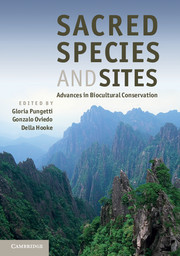Book contents
- Frontmatter
- Contents
- List of Contributors
- Foreword
- Preface
- Acknowledgements
- Introduction
- Part I Concepts and Knowledge
- 1 Sacred species and sites: dichotomies, concepts and new directions in biocultural diversity conservation
- 2 Spiritual values and conservation
- 3 Protected areas and sacred nature: a convergence of beliefs
- 4 Ancient knowledge, the sacred and biocultural diversity
- Part II Sacred Landscapes
- Part III Sacred Sites and People
- Part IV Sacred Species
- Part V Sacred Animals
- Part VI Sacred Groves and Plants
- Part VII Implementation and Conclusions
- Index
- Plate Section
- References
4 - Ancient knowledge, the sacred and biocultural diversity
from Part I - Concepts and Knowledge
Published online by Cambridge University Press: 05 August 2012
- Frontmatter
- Contents
- List of Contributors
- Foreword
- Preface
- Acknowledgements
- Introduction
- Part I Concepts and Knowledge
- 1 Sacred species and sites: dichotomies, concepts and new directions in biocultural diversity conservation
- 2 Spiritual values and conservation
- 3 Protected areas and sacred nature: a convergence of beliefs
- 4 Ancient knowledge, the sacred and biocultural diversity
- Part II Sacred Landscapes
- Part III Sacred Sites and People
- Part IV Sacred Species
- Part V Sacred Animals
- Part VI Sacred Groves and Plants
- Part VII Implementation and Conclusions
- Index
- Plate Section
- References
Summary
And the Spirit of God moved upon the face of the waters.
Genesis 1 : 2Introduction
Man's earliest attempts to seek out a supernatural dimension have often involved nature by interpreting extreme natural phenomena as a manifestation of the divine, or by associating the sacred element with places of special beauty or uniqueness.
Thunder and lightning, which bring fire down to earth, were widely considered gifts from the gods. The myth of Prometheus, who stole fire from Zeus and gave it to mortals for their use, is most probably related to this natural phenomenon (Bonnefoy, 1981):
The child of Iapetus cheated [Zeus] by stealing the far-seen gleam of untiring fire in a hollow narthex [the stem of giant fennel, Ferula communis], Hesiod Theogony 565–7 [mainland Greece, c. 700 bc].
Various cultures, including the Rigveda and Native American tribes, also feature tales of fire being stolen from the gods and given to humans.
Italian heritage and the sacred
In Italy there is a long-standing relationship between people and their sacred landscape (Figure 4.1). In the Iron Age, rural and mountain Italic sanctuaries were important public meeting places for local communities. In archaeological research, ‘sacred landscape’ refers to a network of consecrated areas and temples with different functions and appeal. The construction or destruction of ancient sacred landscapes was often a result, then as now, of conflict or instability: for example, when the Romans damaged or robbed the sanctuaries of their Italic enemies (Stek, 2005).
- Type
- Chapter
- Information
- Sacred Species and SitesAdvances in Biocultural Conservation, pp. 46 - 62Publisher: Cambridge University PressPrint publication year: 2012



